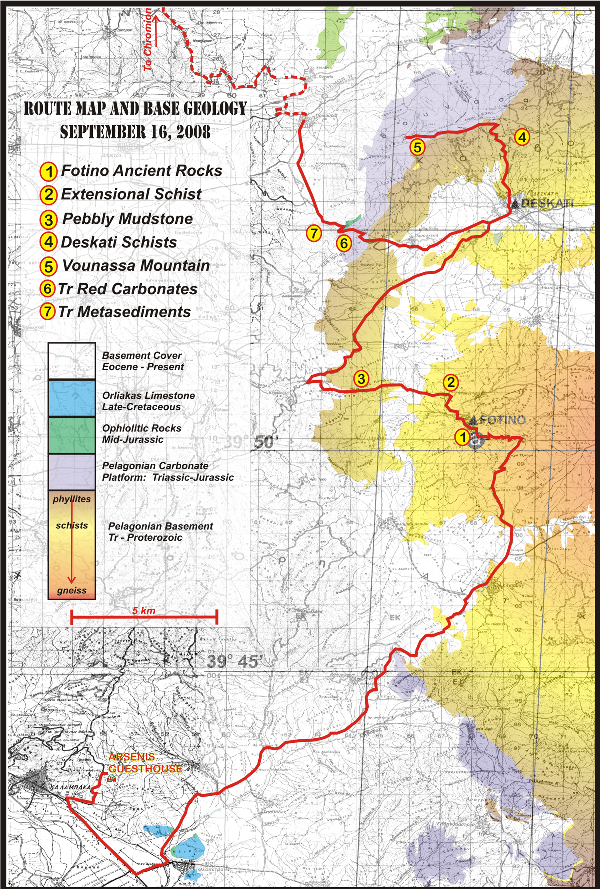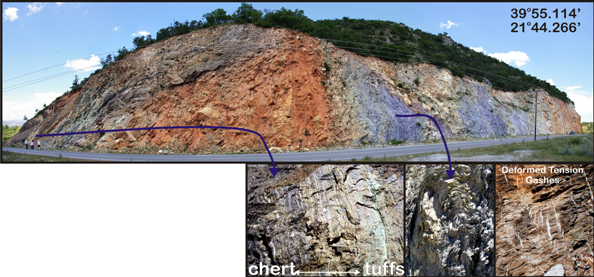Day 2 -THE PELAGONIAN MARGIN
The western margin of the Pelagonian ribbon continent is encountered between the occluding Mesohellenic sediments of Meteora and the Vourinos ophiolite. A traverse across this margin exhibits the essential character of this continental terrane as well as the rocks affected by ophiolitic emplacement.
The Pelagonian itself is essentially a Hercynian continental block, once part of Pangaea, rifted apart with formation of the Tethys (~250 mya). It thus is host to the rift-drift system that, with time, gave birth to the Pindos Basin ophiolites (~170 mya). It is also the “footwall” continent to emplacement of the ophiolitic slab (~168mya). The Pelagonian thus shows evidence for the birth and destruction of the Pindos Basin. Its exhumation apparently followed emplacement of the ophiolitic slab (late Jurassic-mid-Cretaceous?), and only recently have exhumation models been applied to its interpretation as a core complex.
The nature of the Pelagonian continent is one of numerous late Precambrian to early Paleozoic terrane fragments welded in upper Paleozoic time to form part of Pangea. So far, the 700 my zircon age found in altered granodiorite at Fotino represents the oldest rocks of Greece. These irregular terrane fragments, ranging in size from tens of m2 to a few km2, show a strong planar fabric presumably imprinted during Hercyian collision. Nearly all rocks in these areas are derived from intense deformation of the granodiorites. Old sedimentation on Hercynian-Pelagonian lands gave rise to quartzites and meta-greywackes, also highly metamorphosed. Some rocks of probable ocean crust affinity have been interpreted as Paleozoic ophiolites.
The rifting of Pangea split this older terrane: dikes of altered lava (now amphibolites) intrude schistose hosts; irregular bodies of highly deformed meta-basalts and acidic intrusions are rifting related. Stepping towards the rifting margin, towards Vourinos, more detail emerges with lessening metamorphism: sedimentation includes Triassic rocks, at least in part over a sedimentary unconformity with the Permian continent, compatible with origin in a rapidly deepening ocean basin: radiolarian cherts, red (ammonitico rosso) limestones, tuffaceous sediments, greywackes, and pebbly mudstones. These are, in turn, interpreted as overlain by a Triassic-Jurassic carbonate platform. The early Triassic sediments lack precise dating, and could include members synchronous to the platform carbonates.
Initial exhumation of this margin shortly follows the emplacement of the Pindos Basin ophiolites. Close to the Vourinos margin, a deformation “footprint” from this slab may be observed. Elsewhere, strong exhumation phenomena either occludes this, or today's exposures represent greater “core complex” depths.
Exhumation structures are easily recognized in west Pelagonian terrane: they show great extensional movement synchronous to schistose metamorphism, and apparent lower-temperature gravity slippage in areas of higher paleo-topography. Such structures are lacking from Vourinos itself. Exhumation metamorphism and structure recedes near the Vourinos contact: the implication is that this represents the original Pelagonian rift margin, as well as the western exhumation limit.
Stop 1: Pelagonian Margin - Fotino Ancient Rocks
THE OLDEST ROCKS IN GREECE
Zircons from gneissic granites cropping out below the village of Fotino date to 700my, making these rocks the oldest known in Greece. The zircons and Nd-isotope characteristics suggest a Gondwanan origin, closely resembling the East Avalonian terrane. These muscovite granites served as the basement into which the later Permo-Carboniferous Pelagonian granites were intruded. Lower intercept zircon U-Pb ages of 177 - 178 my may indicate a disturbance due to ophiolite obduction onto the western Pelagonian margin.
Consider: How do we distinguish ophiolitic slab imprint from exhumation structures?
Stop 2: Pelagonian Margin - Extensional Schist
EXTENSIONAL DEFORMATION
Past Fotino driving N and NE, rocks cropping out along roadcuts exhibit strong extensional fabrics and a concurrent metamorphic gradation from near gneissic (Fotino) to amphibolite schists, phyllites and “slatey phyllites.” The section appears to be transitional and intact, with no major Cenzoic displacement. The fieldtrip stop is within schist that includes metasediments as well as probable meta-intrusives (meta-diabasic amphibolites). White lenses consist of extremely altered felsic-quartz (altered acidic intrusives?), and deformed quartzite dikes and veins are common. Topping directions seem pervasively to the SW, and these presumably are related to exhumation of the Pelagonian.
Consider: Did a large ophiolitic nappe pass above these rocks, and what is the dating of this nappe movement relative to exhumation?
Stop 3: Pelagonian Margin - Pebbly Mudstone
PEBBLY MUDSTONE
The western exposures of the Pelagonian basement formations are described as lower to mid-Triassic “semi-metamorphic” sediments including micaceous and calcareous shales (present site), red limestones, cipolines and micaceous quartzites. Dating of this entire margin is based on conodonts separated from the red limestones of upper Skythian-lower Anision ages. The present stop consists of phyllitic pebbly mudstones: their relative age compared to the red limestones is unclear. Pebbles are quartzite and schist at this locality, and the matrix consists of highly altered micas, clays (after feldspars) and rare biotite with strong metamorphic foliation and 0.5 cm scale layers. Veins of hydrothermal textured quartz with altered feldspars and pyrite grains strengthen the rock locally (silicified) and are also highly deformed. The kinematics at this site are more complicated than at previous stops, and seem to show both SE and NE topping directions.
Consider: A comparison between these pebbly mudstones (Tr?) with those beneath the sole of the Vourinos ophiolite (Jr?)
Stop 4: Pelagonian Margin - Vounassa Deformation
The schists of this site are considered neo-Paleozoic, and include multiply deformed metasediments and metabasic intrusives. The former includes cherts and greywackes; the latter at this site includes small pods of sulphide deposition in metabasite. Mica schists dominate, with actinolite schists after mafic protoliths; epidote and garnets occur among secondary minerals. Siliceous veins and dikes intrude all lithologies. The original stratigraphic lithologic distribution of ths assemblage is obscured by penetrative deformation imposing strong metamorphic foliation and microfolding. Deformed quartz veins best designate kinematics of late ductile deformation. Metamorphic foliations are subsequently deformed into meter--scale folds apparently related to shear folds along shallow ramp systems. Most ramps in this outcrop top to the NE, and include several generations of brittle deformation. The latest deformation appears to be a set of minor but penetrative steep, narrow reverse faults.
Stop 5: Pelagonian Margin - Vounassa Mountain
VOUNASSA PEAK
Along the top of Vounassa Mountain, an unconformity marks the Permo-Triassic contact between the neo-Paleozoic Deskati schists (to the south and east) and Triassic-Jurassic Pelagonian platform carbonates. The latest ice age left glacial scars and high relief on the carbonates at an altitude within the Hellenic Alpine vegetation zone. The viewpoint spans from Mount Vourinos across the Mesohellenic Trough and to the Pindos. A foreground cover displays a “wormy” geomorphology over carbonate talus and Pleistocene deposits that may be due to karstic weathering (?).
Consider: The distances between Vourinos and the Pindos ophiolites, and whether these relate to their paleo-geographic separation.
Stop 6: Pelagonian Margin - Triassic Red Carbonates
TR RED CARBONATES
The Triassic metasediment unit of the Pelagonian margin is dated by comparison to “Ammonitico Rosso” carbonates similar in appearance to these. Referenced as bearing Skythian-Anisian conodonts (in neighboring IGME Ayiofyllo sheet), it is not known where the original sampling locality is providing this date. Compared to nearby neo-Paleozoic schists, these sediments lack strong deformation, and appear to preserve in situ sedimentary brecciation and in-fill by clays. They appear to be the oldest sediments deposited above the Paleozoic schists, and represent an oceanic, moderately deep-water environment.
Consider: Are these part of early Tethyan Rifting?
Stop 7: Pelagonian Margin - Triassic Metasediments
Called this due to their varied colors, the Triassic metasediments consist of radiolarian cherts (left of photo), tuffaceous sediments, quartzites, shales, mica schists, micaceous and siliceous carbonates. Folding is pervasive on the scale of the outcrop down to handspecimen size. The conventional interpretation is that these metasediments were deposited onto the red carbonates of the last stop, that is, in the same age range as Tethyan rifting. Both these and the neo-Paleozoic rocks are overlapped by the Pelagonian Tr-Jr platform carbonates.
Consider: Does the deformation mark the nearby lateral transport of the Vourinos ophiolite?











